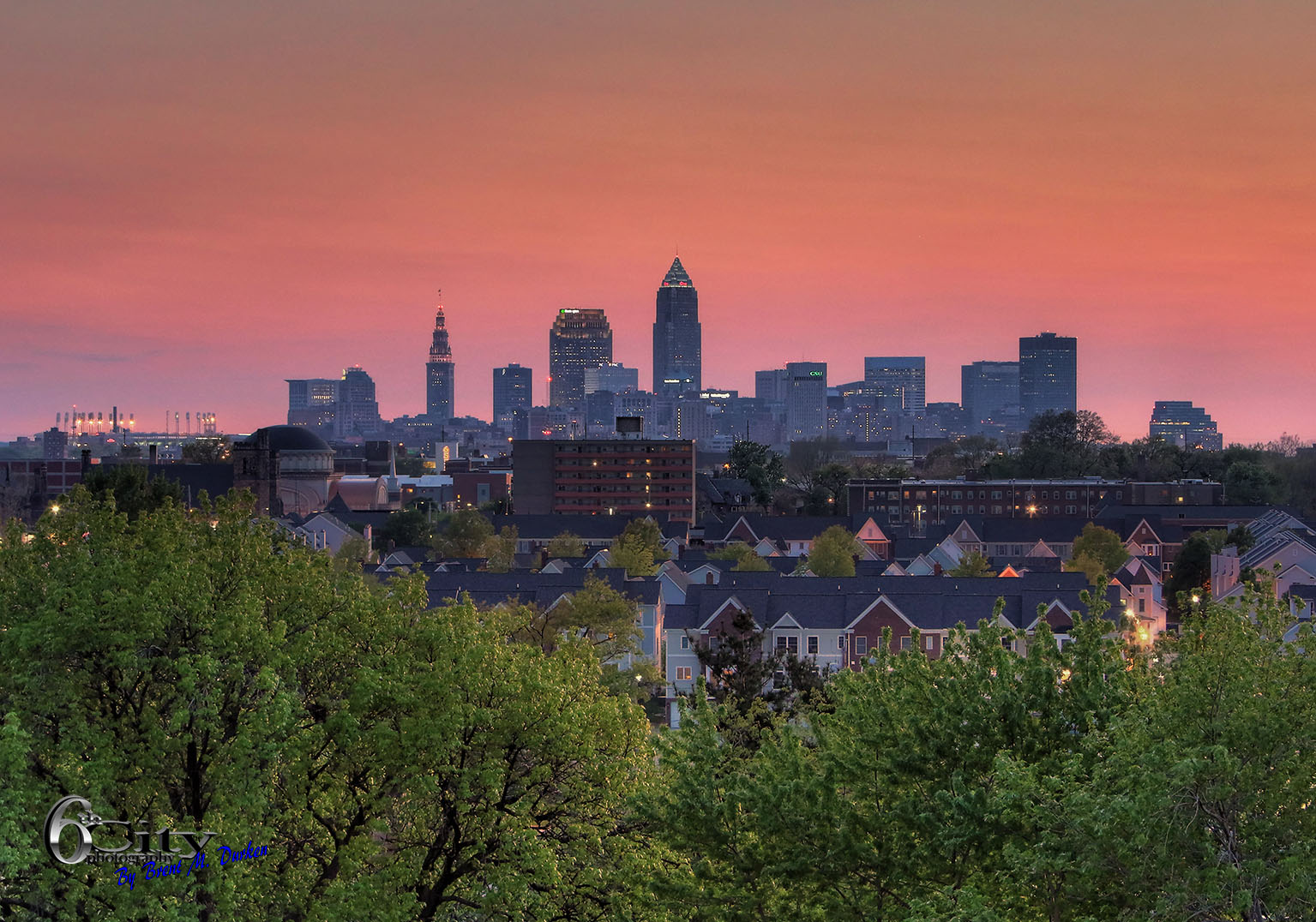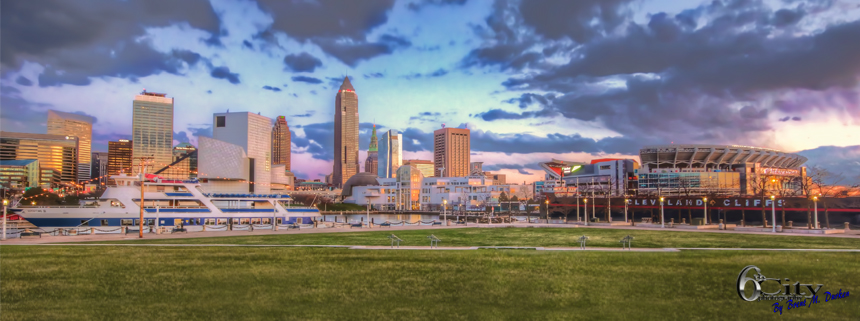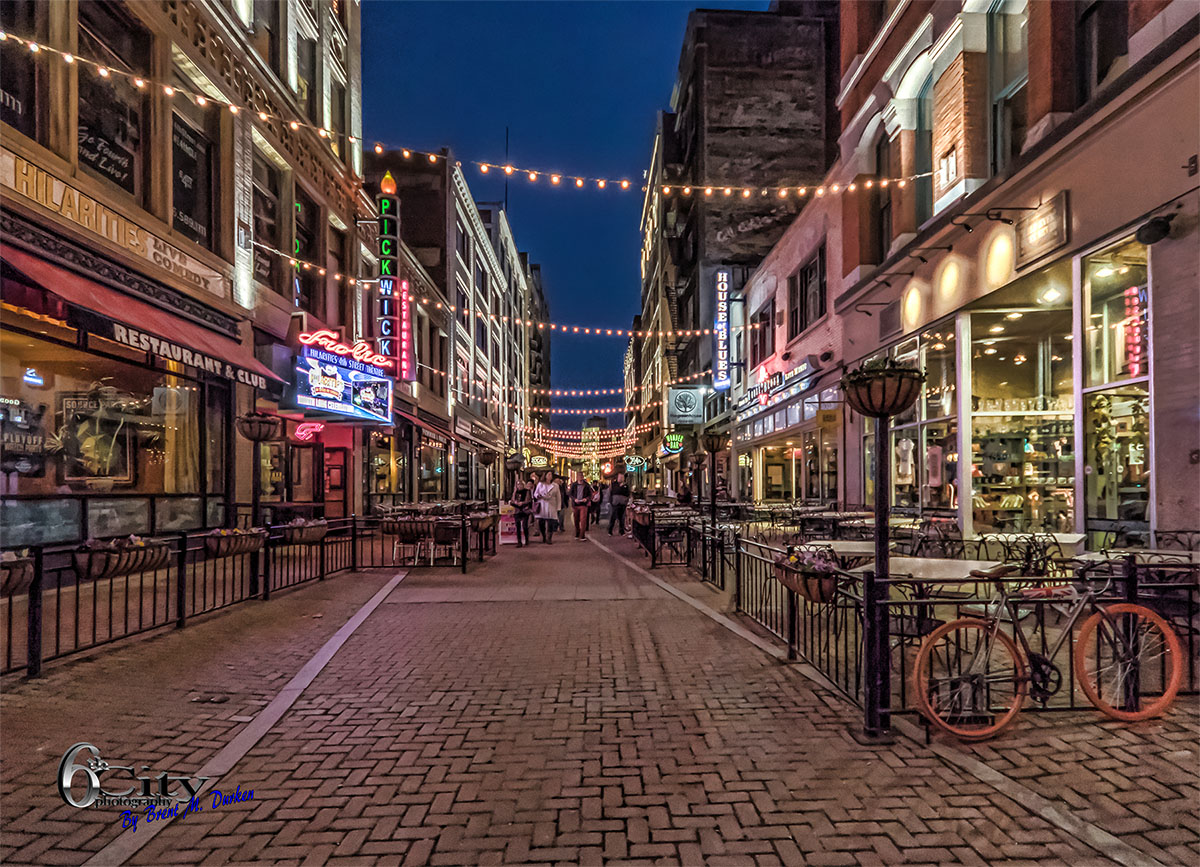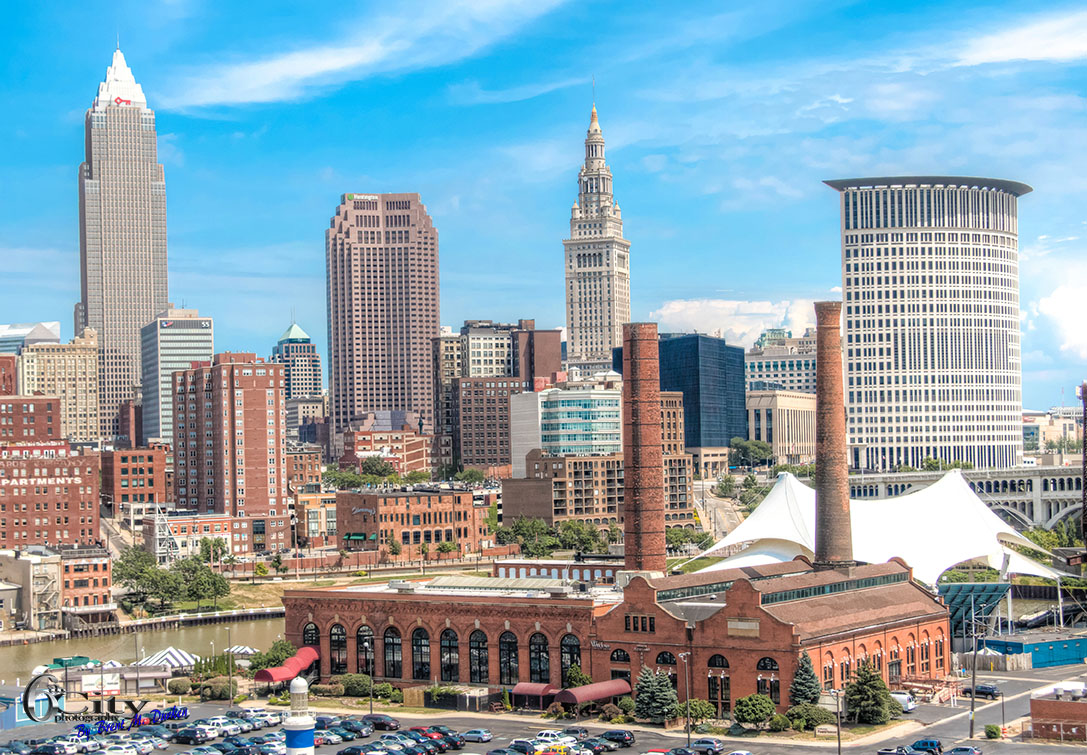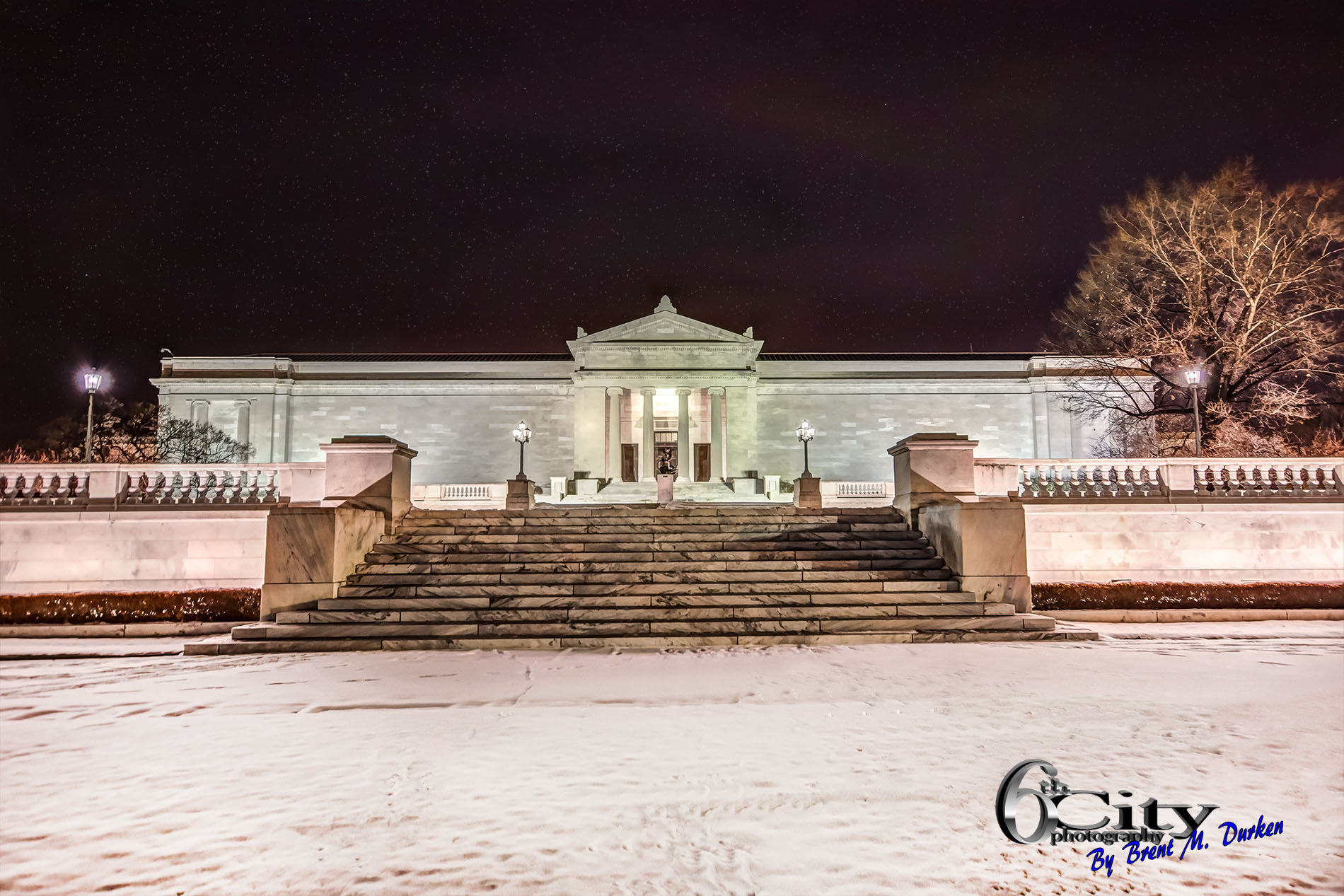Panoramic Cleveland Skyline
Panoramic view of the Cleveland Skyline from Voinovich Bicentennial Park in the North Coast Harbor.
All photos are copyright of Brent Durken – www.brentdurken.com
To purchase a digital download of this photo for your website or blog please visit: https://www.smugmug.com/gallery/n-zRG6xB/
Purchase a print of this photo: Brent Durken Print Sales
Rock and Roll Hall of Fame in Cleveland
 The Rock and Roll hall of Fame has become one of Cleveland’s most recognizable landmarks and a must see for out of town visitors. Here is a little information about the history of the Rock hall from the official website:
The Rock and Roll hall of Fame has become one of Cleveland’s most recognizable landmarks and a must see for out of town visitors. Here is a little information about the history of the Rock hall from the official website:
More than 25 years ago, leaders in the music industry joined together to establish the Rock and Roll Hall of Fame Foundation in New York City to celebrate the music and musicians that changed the world. With that, one of the Foundation’s many functions is to recognize the contributions of those who have had a significant impact on the evolution, development and perpetuation of rock and roll by inducting them into the Hall of Fame.
The Rock and Roll Hall of Fame and Museum opened its doors in 1995 on the shores of Lake Erie in downtown Cleveland, Ohio. The Rock and Roll Hall of Fame and Museum, Inc. is a nonprofit organization that exists to engage, teach and inspire through the power of rock and roll. It carries out this mission through its operation of a world-class museum that collects, preserves, exhibits and interprets this art form and through its library and archives as well as its educational programs.
Officials from Cleveland and the state of Ohio approached the Foundation in 1985 and suggested the construction of a major museum. “We originally planned to purchase a brownstone in New York City in which to house the Hall of Fame, as well as an archive, library and museum,” said Suzan Evans. In November, the city sent a delegation to New York.
“They had these wonderful diagrams for a museum that would be much larger than any town house we had originally thought of,” said Evans. “Our eyebrows were raised, and somebody at the meeting actually passed me a note that said, ‘Pack your bags.’”
As the Foundation considered the offer, several other cities, including New York, Philadelphia, New Orleans, San Francisco, Memphis and Chicago, also made offers. The board members visited each city and were greeted with police escorts, public rallies and marching bands.
The first induction dinner was held at New York’s Waldorf-Astoria Hotel in January 1986. Inductees include Chuck Berry, James Brown, Ray Charles, Sam Cooke, Fats Domino, the Everly Brothers, Buddy Holly, Jerry Lee Lewis, Elvis Presley and Little Richard. Robert Johnson, Jimmie Rodgers and Jimmy Yancey were honored as early influences. The first non-performers honored were producer Sam Phillips and disc jockey Alan Freed. Talent scout/producer John Hammond was recognized with a Lifetime Achievement award.
Meanwhile, Cleveland ranked first in a public poll conducted by USA Today asking where the Hall of Fame should be located. After much competition and many visits to potential sites by Foundation members, Cleveland is chosen as the permanent home for the Rock and Roll Hall of Fame and Museum in May of 1986.
Following an extensive search throughout 1987, world-renowned architect I.M. Pei was chosen to design the Museum. Pei had a lot of learning to do. “I didn’t know a thing about rock and roll,” he confessed.
Not to be discouraged the board members took Pei on trips to Memphis and New Orleans and to concerts in New York. “We heard a lot of music, and I finally got it: rock and roll is about energy,” said Pei. He accepted the challenge of designing the world’s first museum dedicated to rock and roll.
On June 7, 1993, ground was broken for the Museum in Cleveland. On hand were I.M. Pei and various board members, including Ahmet Ertegun, Suzan Evans and Jann Wenner. Inductees and other artists present at the ceremony included Pete Townshend, Chuck Berry, Billy Joel, Sam Phillips, Ruth Brown, Sam Moore of Sam and Dave, Carl Gardner of the Coasters and Dave Pirner of Soul Asylum.
Townshend made one of the museum’s significant donations on this occasion – the Gibson J-200 guitar used to compose Tommy, including the classic “Pinball Wizard.”
A year later, under a hot summer sun and Ruby, a larger-than-life inflatable from the Rolling Stones’ Steel Wheels tour, the Museum was topped off with the last steel beam in its structure. First-year inductee Jerry Lee Lewis, as well as several Cleveland musicians, performed for a crowd that includes Pei, Wenner, Evans and Ertegun.
On October 13, 1994, Yoko Ono presented a major collection of John Lennon artifacts to the Museum. The collection included lyrics, Lennon’s guitar from the 1965 Beatles concert at Shea Stadium, a pair of eyeglasses and the leather jacket Lennon wore while in Hamburg.
In September of 1995 and after 12 years in the making, the Rock and Roll Hall of Fame and Museum opened with a full schedule of events.
On the first day, September 1, the celebration began with a playful parade through the streets of Cleveland, followed by a ribbon-cutting ceremony in front of the Museum. Present for the ceremony were Pei, Ertegun, Wenner, Evans, Ohio Governor George Voinovich, Cleveland Mayor Michael White, Little Richard and Yoko Ono, as well as press from around the world. A gala private dinner attended by board members, celebrities and many Cleveland residents ended the evening in grand style.
The Museum officially opened to the public on Saturday, September 2, which kicked off with a ceremony presenting the Ahmet M. Ertegun Exhibition Hall, the Museum’s main exhibit space named in recognition of the founder of the Rock and Roll Hall of Fame.
The evening culminated with a benefit concert at Cleveland Municipal Stadium. An incredible roster of the rock and roll greats performed– Chuck Berry, Bob Dylan, Al Green, Jerry Lee Lewis, Aretha Franklin, Johnny Cash, the Pretenders, John Fogerty, Lou Reed, Iggy Pop, George Clinton, the Kinks, John Mellencamp, Bruce Springsteen, Booker T. and the MGs, Eric Burdon and Martha Reeves.
Since the Museum’s opening, the Rock and Roll Hall of Fame and Museum has welcomed nearly eight million visitors from around the world and reaches more than 50,000 students and educators each year through its education programs on site and at great distances.
– Take a moment to find out more about this cool museum: http://www.rockhall.com/
All photos are copyright of Brent Durken – www.brentdurken.com
To purchase a digital download of this photo for your website or blog please visit: https://www.smugmug.com/gallery/n-zRG6xB/
Purchase a print of this photo: Brent Durken Print Sales
East 4th Street
East 4th Street is a major downtown neighborhood in Cleveland, Ohio, known for its food and entertainment. The street runs between Euclid Avenue and Prospect Avenue. This area has become something of a trendy hangout and has become a destination for visitors to Cleveland. The area is home to many famous Cleveland restaurants, including The Greenhouse Tavern, Lola, Pickwick and Frolic and The House of Blues. The amazing old Cleveland Arcade is located just across Euclid Avenue from East 4th St.
All photos are copyright of Brent Durken – www.brentdurken.com
To purchase a digital download of this photo for your website or blog please visit: https://www.smugmug.com/gallery/n-zRG6xB/
Purchase a print of this photo: Brent Durken Print Sales
The West Side Market
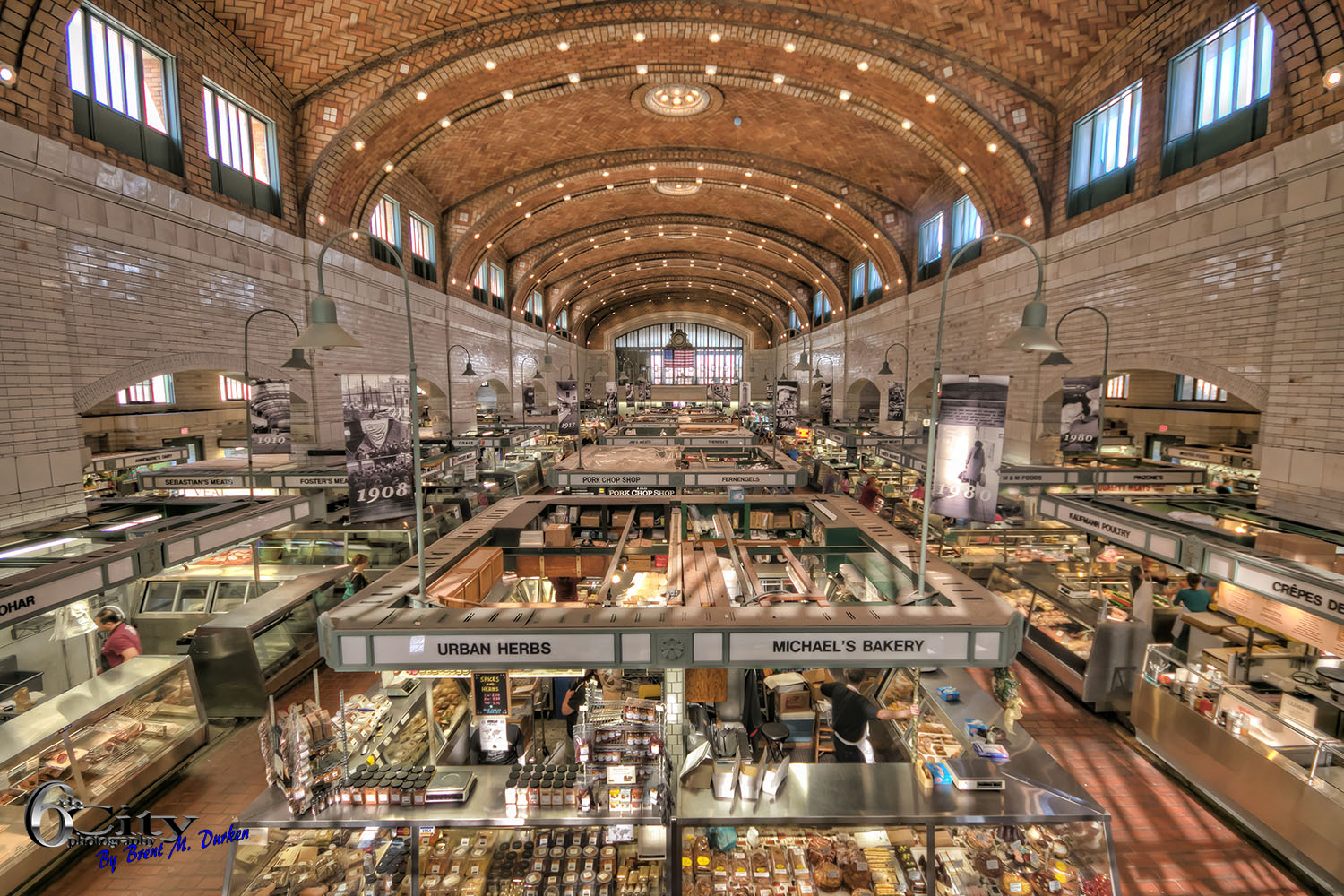 The West Side Market is Cleveland’s oldest public market and is home to over 100 vendors. These vendors offer fresh seafood, fruits, vegetables, meats, baked goods and more. It is located at the corner of West 25th Street and Lorain Avenue in the Ohio City neighborhood.
The West Side Market is Cleveland’s oldest public market and is home to over 100 vendors. These vendors offer fresh seafood, fruits, vegetables, meats, baked goods and more. It is located at the corner of West 25th Street and Lorain Avenue in the Ohio City neighborhood.
From Wikipedia:
“Most residents of the neighborhood, and many Clevelanders in general, still do a large portion of their shopping at the Market. The market is open to customers Mondays and Wednesdays from 7:00 a.m. to 4:00 p.m., and Fridays and Saturdays from 7:00 a.m to 6:00 p.m.
The market attracts tourists from all parts of the United States, who tour the market and learn about its history. Guided tours are offered. Its national profile has been boosted in recent years by coverage on various programs produced by the Travel Channel and Food Network.
Many stalls have remained under individual family control for much of the life of the Market, in a few cases dating back to its 1912 opening. The market’s tenants and sellers reflect the cultural diversity of the surrounding neighborhood and Cleveland as a whole. The current roster of tenants includes those of Irish, German, Slovene, Italian, Greek, Polish, Russian, and Middle Eastern descents, among others.
In the September 2010 issue of Food Network Magazine, the West Side Market was named America’s “Best Food Lovers’ Market.” https://en.wikipedia.org/wiki/West_Side_Market
For more info on this awesome market visit: http://westsidemarket.org/
All photos are copyright of Brent Durken – www.brentdurken.com
To purchase a digital download of this photo for your website or blog please visit: https://www.smugmug.com/gallery/n-zRG6xB/
Purchase a print of this photo: Brent Durken Print Sales
North Coast Rapid Station and First Energy Stadium
Today’s photo blog features a photograph of the North Coast Rapid Station with First Energy Stadium and North Coast Harbor in the background. The North Coast Rapid Station is located along the Waterfront Line, an extension of the Blue and Green lines, travels from Tower City along the Cuyahoga River and Lake Erie. It ends at the South Harbor Station in the Municipal Parking lot, providing access to destinations formerly served by the L-Line Trolley.
Cleveland Browns Stadium became FirstEnergy Stadium, Home of the Cleveland Browns on January 15, 2013, when Browns owner Jimmy Haslam and FirstEnergy President and CEO Tony Alexander announced a long-term naming rights partnership. For more information on First Energy Stadium: http://www.firstenergystadium.com/
All photos are copyright of Brent Durken – www.brentdurken.com
To purchase a digital download of this photo for your website or blog please visit: https://www.smugmug.com/gallery/n-zRG6xB/
Purchase a print of this photo: Brent Durken Print Sales
http://brent-durken.pixels.com/
Cleveland’s Skyline, the Powerhouse and the Nautica Entertainment Complex
Today’s photo features the Powerhouse “Nautica Entertainment Complex” with the Cleveland skyline as a backdrop. The Powerhouse was built in 1892 on the west bank of the Cuyahoga River by Marcus Hanna to power Cleveland’s west side streetcar lines. The powerhouse, which is now a National Historic Landmark was closed in 1920. Streetcars were being used less due to the rise of the automobile.
Today the Nautica Entertainment Complex includes the Powerhouse and is home to the Greater Cleveland Aquarium, Windows on the River banquet facilities and Trolley Tours, the Sugar Warehouse with Shooters on the Water, the IMPROV Comedy Club and Restaurant, Great Lakes Watersports, Jacobs Pavilion, the Nautica Queen dining and cruise ship, and the Apartments at Nautica building with McCarthy’s Downtown.
To find more about this amazing venue: http://www.nauticaflats.com/
All photos are copyright of Brent Durken – www.brentdurken.com
To purchase a digital download of this photo for your website or blog please visit: https://www.smugmug.com/gallery/n-zRG6xB/
Purchase a print of this photo: Brent Durken Print Sales
Cleveland Museum of Art
The Cleveland Museum of Art is truly a treasure here in Northeast Ohio. This world-class museum is free and open all year for families to enjoy. Here is more about the museum from the Cleveland Museum of Art website: “The museum opened on June 6, 1916, after many years of planning. Its creation was made possible by Cleveland industrialists Hinman B. Hurlbut, John Huntington, and Horace Kelley, all of whom bequeathed money specifically for an art museum, as well as by Jeptha H. Wade II, whose Wade Park property was donated for the site. The endowments established by these founders continue to support the museum. The original neoclassic building of white Georgian marble was designed by the Cleveland firm of Hubbell & Benes and was constructed at a cost of $1.25 million. Located north of the Wade Lagoon, it forms the focus of the city’s Fine Arts Garden.
Establishing Programs for Children and Adults
Frederic Allen Whiting was the museum’s first director from 1913 to 1930. An authority on handicrafts, he believed in the museum as an educational institution. Under his leadership, the museum established the education department and a wide variety of programs for children and adults. In 1919 the first “Annual Exhibition of Cleveland Artists & Craftsmen” was held. This exhibition soon became known as the May Show, and continued to showcase local artists for 73 years.
Securing an International Reputation
William M. Milliken served as the museum’s second director from 1930 to 1958. During his tenure the museum continued to prosper, particularly during the 1940s and 1950s, when a series of large bequests, including the Rogers Bequest and the Severance Fund, allowed the purchase of significant works that established the museum’s international reputation.
Three important milestones occurred in 1958. On March 4 the first major addition doubled the size of the museum. During the year the museum also received a sizable bequest from Leonard Hanna Jr., which provided the funds necessary to function in the mainstream of national and international art collecting. Dr. Sherman Emery Lee became the museum’s third director. Lee would be known for his long tenure in the director’s role and the development of the museum’s Asian collection, which ranks as one of the finest in the country. During his directorship another wing, developed by signature architect Marcel Breuer, opened in 1971. It contained special exhibition galleries, classrooms, lecture halls, Gartner Auditorium, and the headquarters of the education department.
Expanding the Collections
In 1983 Dr. Evan Hopkins Turner became the fourth director. Another addition to the museum opened during his tenure. It contained the museum’s extensive library, as well as nine new galleries. Turner’s legacy includes the expansion of the photography and modern art collections and the reinstallation of permanent galleries. He also established the museum’s community-centered focus to ensure the institution’s relevancy to its audiences.
Enhancing Community Connections
Turner’s community-centered outlook continued under the directorship of Dr. Robert P. Bergman, who served from July 1993 until May 1999. A specialist in the art of the European Middle Ages, Dr. Bergman established community advisory committees to act as consultants for exhibitions and programs. Upon the untimely death of Dr. Bergman, deputy director Kate Sellers was appointed acting director and served from May 1999 until March 2000.
Advancing a Great Legacy
On March 13, 2000, Katharine Lee Reid, the daughter of former director Sherman Lee, became the museum’s sixth director. Her special interests included 17th-century European paintings, 20th-century painting and sculpture, and late 19th- and 20th-century American and European decorative arts. Under her tenure, ground was broken for the Rafael Viñoly-designed renovation and expansion of the entire museum complex. Mrs. Reid retired in 2005.
Building for the Future
Succeeding Katharine Lee Reid in April 2006, Timothy Rub became the seventh director of the museum. With a background in architecture and modern and contemporary art, Mr. Rub brought 20 years of museum experience to Cleveland. The museum’s renovation and expansion project continued under Mr. Rub, with the renovated 1916 Beaux-Arts building reopening in June 2008 and the new east wing in June 2009. Mr. Rub resigned as director in September 2009 to become director of the Philadelphia Museum of Art. Deborah Gribbon, a former director of the J. Paul Getty Museum, served as interim director until September 2010.
David Franklin, an internationally respected scholar of Italian Renaissance and baroque art, was the museum’s ninth director; his term ended in October 2013. Fred Bidwell, the retired executive chairman of JWT/OgilvyAction, a national advertising agency serving leading brands with more than 500 employees, served as the museum’s interim director.
William M. Griswold was named the tenth director of the museum in May 2014, and is currently leading the museum as it approches its centennial anniversary”.
Make sure to check out more about this amazing museum here: http://www.clevelandart.org/
Purchase this photo: Brent Durken Print Sales
Squires Castle in the Cleveland Metroparks
Squires Castle is an amazing place that reminds you of a bygone era in Cleveland history. Great place to take photographs and to take the kids to explore. Information on Squires Castle from the The Encyclopedia of Cleveland History : “Squires Castle is a picturesque castellated and turreted ruin on Chagrin River Rd. in the N. Chagrin Reservation of the Cleveland Metroparks. The irregular stone structure was originally built as part of the estate of Feargus B. Squire (1850-1932), vice-president and general manager of the Standard Oil Co. (OHIO) until 1909. Attracted by the beauty of the Chagrin Valley, Squire purchased 525 acres there in the 1890s. He engaged a New York architect and planned 2 buildings in the style of English or German baronial halls. The existing structure was erected to serve as a gatehouse and caretaker’s quarters, and the estate was improved with groves of trees, ponds, bridges, and miles of gravel roadway. The main residence was never built, and Squire built his principal home in Wickliffe. In 1922 the property was sold to a private land developer, and it was acquired by the Metropolitan Park Board in 1925 as the beginning of the N. Chagrin Reservation. Seriously vandalized and deteriorated, the gatehouse is now only a shell consisting of the stone and brick walls. Popularly known as “Squire’s Castle,” it is used as a shelterhouse and picnic area by park visitors. Renovations in 1995 included painting the ground floor of the castle with a waxed coating to deter vandalism”. Read more about Cleveland’s amazing history: http://ech.cwru.edu/
For Directions to Squires Castle follow this link: https://goo.gl/maps/ahPx9VVfndM2
Purchase this photo: Brent Durken Print Sales
http://brent-durken.pixels.com/
Cleveland’s North Coast Harbor
This weeks photo blog features Cleveland’s North Coast Harbor on a warm spring day. North Coast Harbor is home to amazing venues such as the Rock and Roll Hall of Fame and Museum, FirstEnergy Stadium, USS Cod, Burke Lakefront Airport,the Great Lakes Science Center, Voinovich Bicentennial Park and the William G. Mather Maritime Museum. The harbor has be recently renovated and it is now possible to dock your personal watercraft or rent jet skis or kayaks.
Purchase this photo: Brent Durken Print Sales
http://brent-durken.pixels.com/
